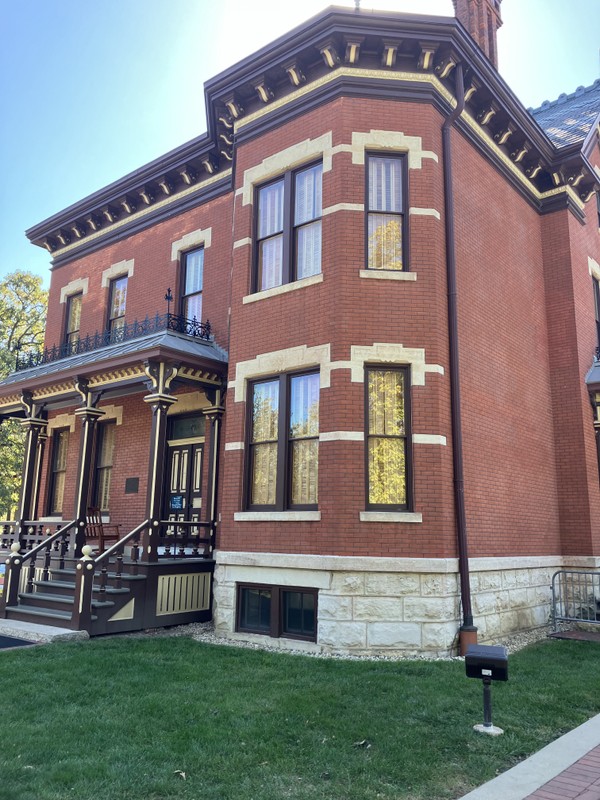Martin- Mitchell Mansion
Introduction
Author-Uploaded Audio
00:00 / 00:00
Listen to a narration of this entry's description by Jessica Toran.
Text-to-speech Audio
Both immigrants from Scotland, George Martin III and his wife Sibelia met in Naperville, married in the 1850s, and had four children together. Operating a limestone quarry business, Martin saw a boom following the Great Chicago Fire of 1871. Almost a decade after the business boom, George Martin began constructing his three-story brick house in 1883. The new house was situated on the rural edge of downtown Naperville. Surrounded by 212 acres, this new structure stood like a castle, overseeing farmland and Martin’s rock quarry pits, which had also furnished many of the foundations upon which the town’s buildings rest. Martin hired Joseph A. Mulvey from Aurora to design a house that celebrated his success as a businessman. The mansion shows a variety of popular Victorian architectural styles. When used together, they are commonly referred to as Victorian Eclectic style. The Italianate style is the most dominant on the exterior façade of the mansion. This style was inspired by Italian villas and was popular in the United States from the 1860s through the 1880s. Other popular Victorian architecture features on the house include the porch’s overall High Victorian Gothic appearance, similar to the Century Memorial Chapel at Naper Settlement. The roofline is a Second Empire style, best characterized by a mimicked mansard roof, or a four-sided roof with two slopes, with the lower slope at a steeper angle than the upper. In honor of their Scottish heritage, the Martins named their estate Pinecraig. After his father died when he was fifteen, George Martin not only tended to the family farm, but also expanded his family’s land to include a quarry on the DuPage River. In the 1850s, Martin had developed a commercial quarry that was advertising lime and building stone in the local paper. Following the Chicago Fire in 1871, stone and gravel were at a premium. By 1872 Martin, along with partner Ernst von Oven, had developed another business, the Naperville Tile and Brick Works. The timing was perfect. The Martins themselves represented a typical Victorian success story. While most Naperville residents still ate in the kitchen, Martin, his wife, and their three daughters, Elizabeth, Catherine, and Caroline, could leave behind the dynamite blasts and dust of the quarry for fine, formal meals in a dining room. Their house featured new technologies of the day as well, such as electricity, the telephone, and indoor plumbing. George Martin died five years after the completion of his house, leaving his businesses to his daughters. The estate was eventually left to his youngest daughter Caroline, who deeded it to the city of Naperville as a museum and park in 1936. Pinecraig and its carriage house are the only buildings on Naper Settlement grounds that are currently standing in their original location.
Images

Backstory and Context
Text-to-speech Audio
Built at a time of innovation and advancements in technology, Pinecraig showcases several of these features throughout the home. Between 1890 and 1920, Naperville residents began receiving services such as water, sewage, and electricity, many of which can be seen throughout Pinecraig. Upon entering the mansion, guests would immediately see an electric-powered chandelier. While the lightbulb might look dim to our eyes, this was bright in comparison to a kerosene or candlelight lamp used in the 1800s. For the first time, people could have light shine down and illuminate what was beneath the light source. With this being such a new amenity, wall outlets were not yet invented. In order for a desk lamp to work, the lamp must be wired through a lightbulb socket on a lowered chandelier, much like the one you can see in the outer office. Unlike most American households who added indoor plumbing to their homes in the 1920s and 1930s, the Martins had this in their home from day one. Using their own wells and cisterns, the Martins could bring water into the house. A boiler and wood burning stove could heat up water for various uses; however, water temperatures would range between lukewarm and cold. In the first few decades of its history, the Martins heated Pinecraig using coal burning fireplaces in six rooms as well as portable stoves. As time went on, the family was able to put in radiators throughout to better heat their home. First invented in 1855 by Franz San Galli of Russia, radiators heat up water, which creates steam in the radiator. This heats up the metal which heats the surrounding area via radiation and convection. While Pinecraig features many new music and entertainment technologies of the time, one that truly stands above the rest can be found underneath the staircase, the telephone. The first telephone company came to Naperville between 1883-1885 as the telephone’s popularity exploded. The Martin family was one of the first local families to have a telephone for business reasons. They shared their line with five other telephones in town. Early telephones used party lines, which meant you could not make a call if someone on the line was already on the phone, people in different locations could listen in, and each phone had a personalized ringtone.
Cite This Entry
Amber Foster on behalf of Naper Settlement and Jessica Toran. "Martin- Mitchell Mansion." Clio: Your Guide to History. October 14, 2024. Accessed April 23, 2025. https://theclio.com/entry/185991

